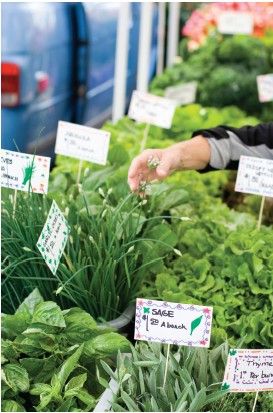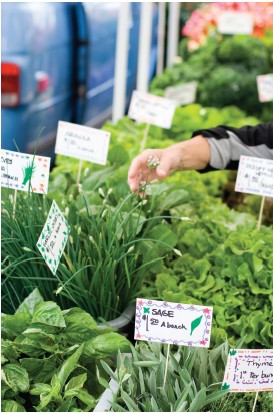Local chef and nutritionist shares love of herbs in delicious spring recipes

 By Shannon Sweeney
By Shannon Sweeney
Living most of her childhood in suburban Connecticut with a mother who loathed cooking, Jeanie Redick’s kitchen experience stretched no further than post-meal clean up. “Her fare was simple and she hated mess more than she hated to cook,” recalls Redick of her mother. Learning the fundamentals of cooking would have to be gained elsewhere. “I will never forget the miracle I witnessed when we turned regular apples into applesauce,” she says of her introduction to food prep in home economics class. “I thought Mrs.
Green was a genius!”
However, it wasn’t until meeting her husband Ken in a pottery studio in college that Redick was introduced to cooking beyond the basics. “My husband had a much richer culinary background,” she says, describing his summers as a chef at Martha’s Vineyard. Following college, she and Ken relocated to a much warmer Tennessee where they enthusiastically practiced organic gardening, and where Redick discovered her newfound love for vegetables. “They tasted so much better out of the ground than out of the can!”
she says.
Everything from the Redick kitchen was made from scratch; from bread and yogurt to tofu and granola, the Redicks relished in grassroots food preparation. From then on, they shared kitchen duties and have lived the past 32 years by the golden rule that “the cook doesn’t clean!” Redick’s aspiration to share her love for fresh, wholesome and healthy foods inspired her to conduct cooking classes from her home. Five children, thousands of miles and many years later, the Redicks settled their family in Roanoke, where
Redick’s longing to help others realize the joys of healthful cooking resulted in the creation of Eat For Life in 1999. Specializing in customized dietaryprograms, Eat for Life assists clients in developing personalized menus and healthy consumption habits through individual counseling sessions and group cooking classes. Redick’s classes address a vast array of dietary needs, including Gluten-free, wheat-free and vegetarian.
In the spirit of spring, Redick shares the joys of discovering culinary herbs. While in college, a roommate shared with her some advantages of using the inherent flavor of dill. “Libby taught me how to turn any salad—egg, tuna or potato—from mundane to gourmet by just adding dill! My son JJ discovered its worth on scrambled eggs,” she says. While the Redicks generally incorporated herbs into their dishes, it wasn’t until traveling abroad that they realized all this natural bounty had to offer. “We have always loved fresh herbs, but were not smitten by them until a recent trip to Italy where we celebrated our 30th anniversary,” she says. While visiting Tuscany, the Redicks quickly befriended Chef Lucia Zucconi, and Redick’s herbal interests were rekindled. Here she learned a great deal about herbs’ ability to naturally enhance the flavors of food without adding sugar or salt. “As a nutritionist, I implore my clients to reduce fat and sugar from their diets,” and to seek alternatives to commercial and synthetic approaches to flavor enhancement, she explains. Zuccino shared with the Redicks new twists on bread and potatoes with the simple addition of rosemary and sage. “My son David discovered a way to turn hummus and pita points into a disappearing magic act!” boasts Redick of the inclusion of herbs into his traditional recipe.
Another herbal staple in the Redick garden is basil. Easy to grow and maintain, basil is an ideal herb for patio or pot gardens. “This past summer, we had a bumper crop of basil and had bruschetta on the screened-in porch nearly every evening with dinner,” she says.
Another easy-to-grow herb is peppermint—a great digestive that offers flavorful and aesthetically appealing contributions to
a variety of beverages. Because peppermint grows abundantly, Redick recommends drying it for year-round enjoyment by
simply bundling harvested plants and allowing them to dry while inverted. Dried leaves can be stored in glass jars and used
for tea whenever cravings for a warm, aromatic beverage arise. Since opening the doors of Eat for Life, Redick has been
walking the path of better eating alongside her clients and continues to coach those hoping to improve their physical and
emotional wellbeing through the natural benefits of food. Here, Redick shares some authentic Tuscan recipes from the kitchen
of Lucia Zuconni. Naturally embellished with the flavors of fresh herbs, these simple recipes are sure to deliver a palate-pleasing
performance, packed with the nutrition your body will adore.






